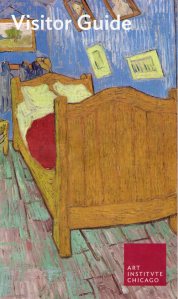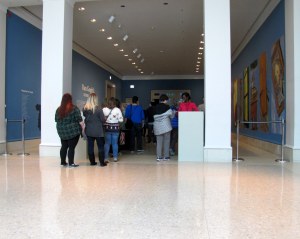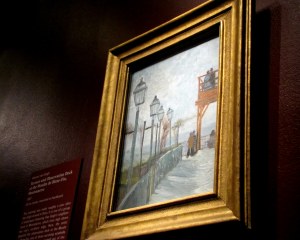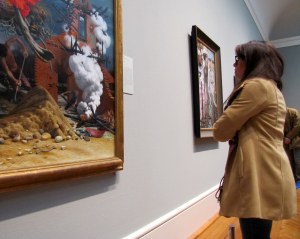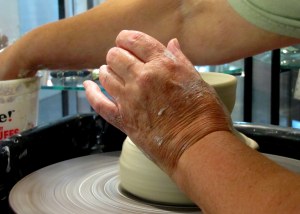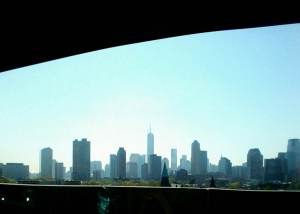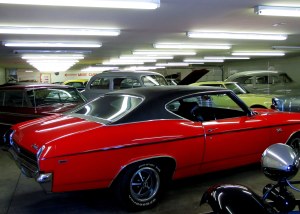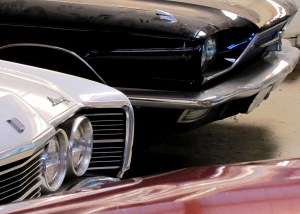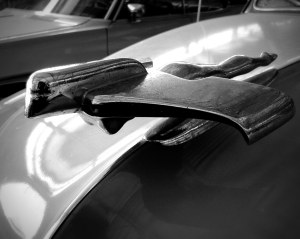Powell Gardens’ history began as land bought by a business man, and has grown to be a 915-acre behemoth thirty miles east of Kansas City, Missouri, consisting of eight themed gardens, a nature trail and an esteemed chapel . During “peak season,” tickets may be purchased for a trolley that loops the grounds, providing a quick overview of the campus.
Being a member of the Missouri Botanical Garden in St. Louis (my home base), I decided that my road trips would be visiting reciprocal membership gardens. I had heard of Powell Gardens, and decided to make that the starting point.
Misha and I left well before sunrise on an April Saturday morning, treating ourselves to cups of Tim Horton’s coffee before taking I-64 to I-70, westbound. It was a fairly leisurely drive, since we had no fixed time schedule. My wheelchair was stowed in the back of his car, and I had water and fruit. [For why I have a wheelchair, see What Three Years Can Do.]
We arrived around 10 AM. The sky was clear, and the wind a bit brisk. Parking in designated handicap slots was easy to obtain this early in the morning, and the roll to the Visitor’s Education Center was fairly level, if a little bumpy, crossing one internal roadway to the building.
Now, anybody who knows me knows my primary interest is in taking photos, so, in my wheelchair, I had my camera around my neck, a travel pack around my waist, and a plastic handle bag on the chair arms for my water and snack. I had my cane bungeed to the left armrest.
At the Visitors Education Building, the door was opened from the inside by a greeter, who cheerfully gave us maps, and then we went to it. First stop was the Conservatory to see the Blue Morpho Butterflies. I was allowed to stay in my chair, but my travel pack and snack bag had to remain outside lest some butterfly try to escape and violate USDA regulations. The Conservatory was humid as expected, but I did not expect to get actively misted (and neither did my camera). The walkway around the Conservatory viewing area was wide enough for the wheelchair, provided no one wanted to pass me in two different directions.
I felt claustrophobic, and headed out to the main gardens… except that I couldn’t find any clearly marked doors to the gardens, nor power-assisted/handicap accessible doors. I had to ask for directions.
Once out, I found that the garden walkways were mostly switch-backed, and the slopes were unsettling. For the rest of my visit, I was more concerned with not losing control of the chair than I was with trying to compose photographs.
I managed to work my way up the inclines from the Island Gardens (two person-wide walkway ending in sloped vegetation into the lake) to the Chapel, which is truly a breathtaking place. As I approached the beautiful wood doors, I wondered how to enter without scratching or denting them. Luckily, strangers opened both doors so I could roll in without damaging anything.
I texted Misha and said I was heading back to the Visitors’ Center. He suggested that I take the trolley back, but I really felt like getting in the additional workout by wheeling back. Then I realized I would be going downhill, and I didn’t want to, so I said I would take the trolley — and then realized that I would have to fold up my chair and climb into the trolley for the return trip.
The trolley is not handicapped accessible. There is no lift for a wheelchair.
Misha, who is a part-time superhero, came out to the Chapel and carried my chair into trolley for me.
I tried to spend money in the gift shop, but was prevented because the aisles were tightly packed with things leaning out or lying on the floor — I was constantly afraid of breaking things or getting them caught on my chair.
As we left, we noticed parking right by the front of the Visitors’ Center. The area was not marked handicap parking leaving us to conclude that it was reserved for staff or volunteers.
Now, it’s 2016, y’all.
The Americans with Disabilities Act has been law since 1990. Many people live their lives differently-abled and independently. Not everyone in a wheelchair has an attendant or an aide. I should be able to go and explore a botanical garden without having to rely on or wait for other people to open doors for me. I should be able to concentrate on my avocation of photography without fearing losing control of my wheelchair.
That’s what the ADA is about – independence to experience life.
I would not recommend Powell Gardens to someone with a manual wheelchair like I have, and even if you’re going with someone for company, if you have mobility issues, avoid the trolley. It’s picturesque, but it’s difficult to climb in and out of.












